This was published 8 years ago
Nicaragua, Central America: The country travellers haven't yet discovered
By Ute Junker
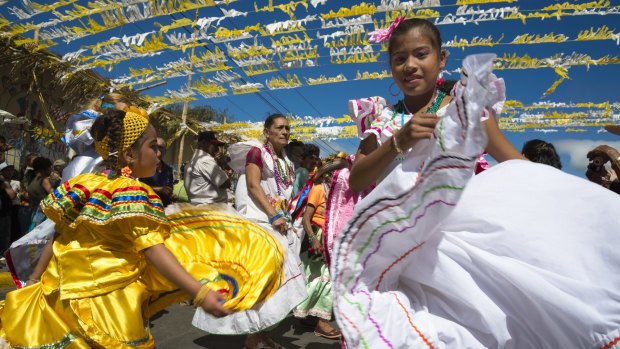
Traditional dancers in Diriamba, Nicaragua.Credit: Margie Politzer
There is no sleeping in in the city of Leon. Even for those nestled, as I am, behind the sheltering walls of a converted convent – walls thicker than anything built in the intervening three centuries – 7am is wake-up time. That is when a loud siren sounds across the town, rousing any sleepyheads and reminding them that it is time to get up and go to work. A second siren sounds at midday, announcing f lunchtime.
It is an odd ritual, redolent of life on a plantation. A local tells me the practice used to be common across Nicaragua. Back when workers were too poor to afford clocks or watches, it ensured everyone got to work on time. Today, the only place it is still practised is in Leon, which seems slightly odd, given that this is Nicaragua's foremost student city. Perhaps it is the only way they can get students to show up for their morning lectures.
I have never come across a city-wide wake-up call anywhere else in the world, but then, Nicaragua is different. Central America's poorest country has a lost-in-time feeling, with a laidback pace that has disappeared from most corners of the globe. The country does not feature on many must-visit lists, but it is hoping to change that, aiming to reinvent itself as tourist destination. Given its magnificent natural attractions, from soaring volcanoes and massive lakes to dense jungles and wonderfully preserved colonial cities, it should be an easy sell.
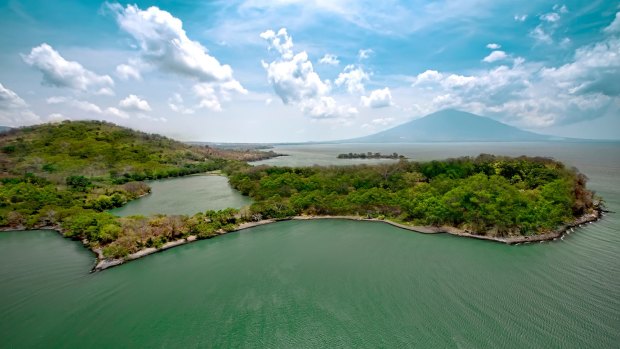
Lake Nicaragua with Ometepe in the background.Credit: Roberto Zuniga
Unfortunately, Nicaragua also has one hell of an image problem. The last time the world paid it any attention, the country was mired in a decade-long civil war, which began when the Sandinistas overthrew the corrupt dictator Anastasio Somoza. Counter-revolutionary forces known as the Contras, backed by the Reagan administration in the US, fought the Sandinista regime led by president Daniel Ortega. The conflict came to a peaceful end with the 1990 election, when the Sandinistas were defeated by the UNO coalition, led by Violeta Barrios de Chamorro.
That was 25 years ago. Today's Nicaragua is a tranquil, welcoming place. Although half the population lives below the poverty line, this is one of the safest countries in Central America, and warm smiles greet me everywhere I go.
The small-town charm of Leon, where I start my travels, belies its status as Nicaragua's second largest city. Low-slung houses line the narrow streets – in earthquake-prone Nicaragua, high-rise has never really taken off – painted parrot-bright in pink and blue, green and yellow. Horse-drawn carts jostle for space with cars, and farmers sit by the side of the road selling pineapples and mangoes, melons and apples.
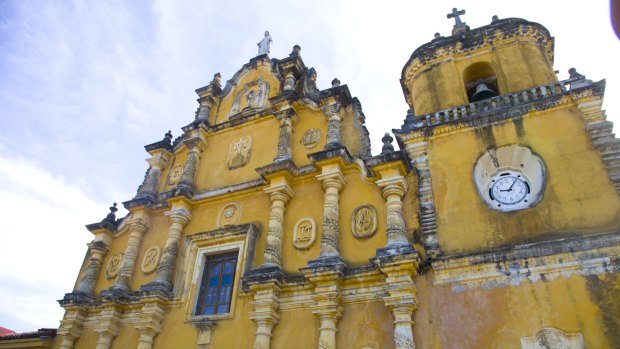
The imposing facade of Leon's cathedral.Credit: Aldo Pavan
Leon's handful of tourist attractions includes a collection of contemporary Latin American art and the Galería de Heroes y Martires, honouring Sandinista martyrs. Its biggest attraction – literally – is the cathedral. For a small fee, you can climb on the roof and admire the best view in town; however, the most intriguing thing about the cathedral is why such a small town needed such an overblown edifice. I ask my guide how Leon ended up with such a grand place of worship. "They mixed up the plans," he tells me with a shrug. "This one was meant to be built in Peru."
I spend most of my time in Leon wandering the streets, admiring the (sometimes crumbling) colonial houses and churches and the colourful murals that festoon many walls, or sitting in squares watching the dramas of daily life unfold. In the evenings, I join the locals in restaurants where wooden shutters are folded back to allow in the balmy air, feasting on indio viejo (shredded meat with onions, garlic, sweet pepper and tomato) and gallo pinto, rice fried with onion and sweet pepper, served with red beans.
One lazy afternoon, wandering through shadow-filled back streets, I come across something surprising: a bustling French bakery, crowded with backpackers who look fresh from a Benetton ad, chowing down on cheap but filling baguettes while tapping in to the free Wi-Fi. And that's when I realise what really makes Nicaragua different. Nobody else has discovered it.
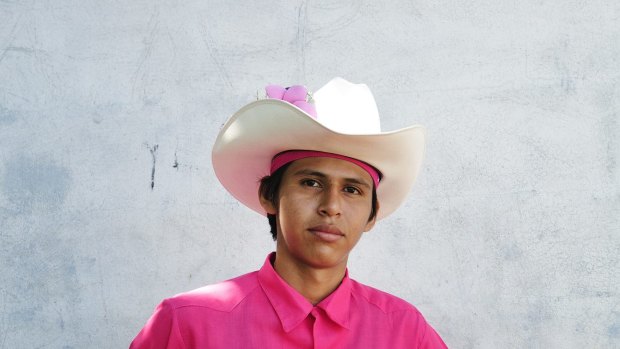
A man in traditional dress in Catarina, Nicaragua. Credit: Christian Heeb
So far, I have occasionally crossed paths with other travellers: a table of Dutch tourists in a restaurant one day, a young German couple buying handicrafts from a street stall on another. However, they are few and far between. Unlike other Latin American cities, Leon does not have rows of cafes and hostels where backpackers congregate. There is not even a McDonalds.
It would be wrong to say Nicaragua is like nowhere I've ever been. But it's like nowhere I have been for the past 15 years. That is about how long it has been since I was in a destination where I felt I had beaten the crowds. There are plenty of other countries where tourist numbers are low – Azerbaijan, say, or Ethiopia – but they are not necessarily countries where you can easily wander around on your own. Nicaragua is.
Not that I'm doing it all on my lonesome. Like most visitors, I have organised a car and driver to take me between destinations. My guide gives me an introductory tour in each new place that we visit. Then I strike off on my own.
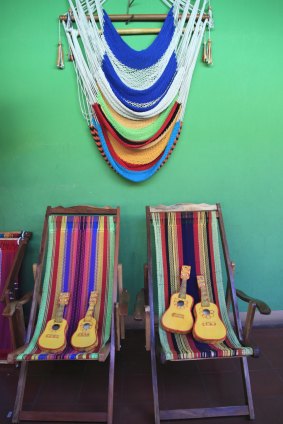
Artisans market, Masaya, Nicaragua.Credit: Wendy Connett
I am delighted by how easy everything is. The roads are surprisingly good: the long-distance highways are in superb condition, although in some more remote locations, dirt roads make for a jarring trip. In the cities, boutique hotels are springing up in old convents or mansions built around leafy courtyard gardens. Nicaragua even has its own five-star resort, Mukul, which has attracted celebrity guests such as Michael Douglas and Matt Damon.
Celebrities aren't the only ones in on the secret. I run into Japanese travellers at coffee plantations and at the country's premier distillery, Flor de Cana, where I also discover the joys of 18-year-old rum. I meet Americans hiking up volcanoes and trekking through jungles, and Britons kayaking on lakes. If I had made it to San Juan del Sur – the country's premier surf spot – I'm told, I would have seen travellers in their dozens.
I skip the surfing, concentrating instead on the country's magnificent lakes and forests. Standing on the shore of Lake Managua as waves roll in towards me, I feel as if I am on the edge of an ocean. Lake Managua may be impressive, but it is dwarfed by the massive Lake Nicaragua, which is about the same size as Puerto Rico. It is home to about 400 islands, including Ometepe, surmounted by twin volcanoes.
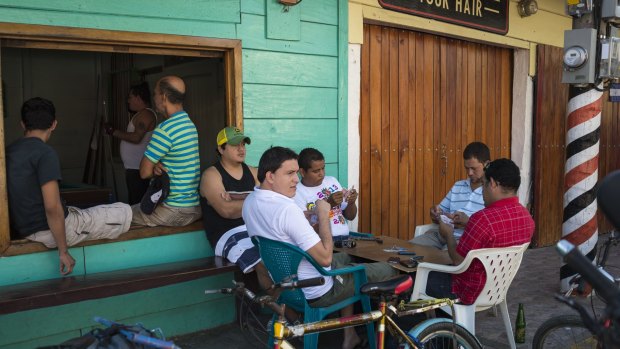
Men playing cards, San Juan del Sur, Nicaragua.Credit: Margie Politzer
Volcanoes are a Nicaraguan speciality. The country has 19 of them, nine of which are active. At Masaya Volcano National Park, we are swathed in sulphur fumes as we stand on the rim of the crater known as the Mouth of Hell. Mombacho volcano, by contrast, is covered in a lovely cloud forest, where we spot monkeys and tiny orchids.
My favourite thing about Nicaragua, however, is the people. Despite the decades of turbulence, despite the poverty, they are optimistic and resourceful. In a street market in Leon, where vendors display their goods on the footpath, I find a man selling banknotes from the revolutionary era. The notes illustrate the massive inflation that racked the war-torn country: a note originally issued at 20,000 cordobas has been overprinted, its new value: 500,000 cordobas.
Seeing my interest, the vendor starts telling me war stories. Like every other Nicaraguan I meet, he is fiercely political. Everyone seems happy to share their opinion, particularly about the president: none other than Ortega, the revolutionary Sandinista leader who was voted back into power in 2006.
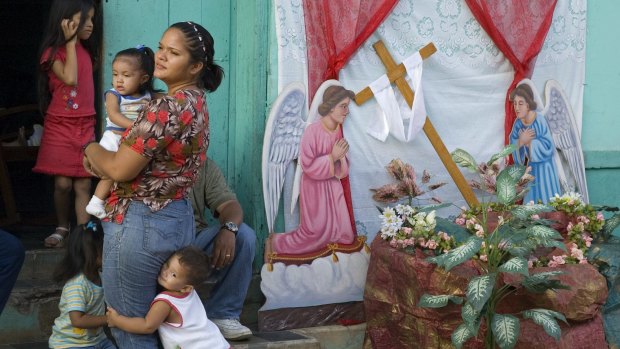
A family watches a procession during Semana Santa.Credit: Margie Politzer
No one approves of his changing the constitution to allow himself to stand for re-election; however, among the people I speak to, Ortega seems to have at least as many supporters as detractors. Even his detractors admit that some of his policies have been good for the country, particularly in making education accessible to all.
Nicaraguans find the funny side in everything, including politics. My guide tells me that one of the candidates in the last presidential election was a corrupt former minister – wanted internationally on money laundering charges – who was surprised when he failed to garner any votes. He rolls his eyes. "We're slow," he says, "But we're not that slow."
TRIP NOTES
MORE INFORMATION
GETTING THERE
Delta Airlines has a daily non-stop service from Atlanta to Managua, and a weekly service from Los Angeles. See www.delta.com
STAYING THERE
In Leon, Hotel El Convento is in a 17th-century convent, and has rooms from $93 a night. Hotel La Perla, set in a colonial mansion, is another elegant option. Rooms from $67. See www.elconventonicaragua.com, www.laperlaleon.com.
TRAVELLING THERE
Gray Line Nicaragua offers a five-ight itinerary with private guide, taking in Leon, Granada and Masaya and Mombacho volcanoes. It costs from $1300 a person twin share, including accommodation, transfers and breakfasts. See www.graylinenicaragua.com.
The writer travelled with the assistance of INTUR, the Nicaraguan Tourism Board.
FIVE NICARAGUA MUST-DOS
BE A LAVA LOVER
Climb one of Nicaragua's 19 volcanoes. At Telica, you can see molten lava in the crater, and explore hot springs at its base.
GO BIRDING
Nicaragua's tropical forests, rainforests and mangroves give birdwatchers a huge range of species to spot, from woodpeckers and parakeets to quetzals and kingfishers.
CATCH A WAVE
The Pacific coast is known for its superb surf: the beaches near the tourist hot spot of San Juan del Sur are the most popular.
BECOME A RUM RUNNER
Flor de Cana rum is Nicaragua's most prestigious export, with a bottle of its top shelf Centenario 25 selling for about $200. Discover what the fuss is about with a distillery tour.
DRINK IN THE HISTORY
Nicaragua's colonial cities, Leon and Granada, are beautifully preserved and easy to explore on foot.
FOUR OTHER TOP DESTINATIONS IN CENTRAL AMERICA
With verdant forests, Mayan ruins and plenty of high-octane activities, Central America offers something for every taste.
COSTA RICA
Looking to ease yourself into the Latin American experience? Then start with Costa Rica. The country's compact size and sophisticated tourism infrastructure makes getting around a breeze, and the many lodges and resorts around the country include some of the best in Central America.
Eco-adventurers will love hurtling through the forest canopy on zip lines or rafting along river rapids. Wildlife spotters will thrill to see colourful tucans and somnolent sloths, gambolling monkeys and neon-coloured butterflies, while those looking to chill out can relax along the coast.
Popular destinations include the Monteverde Cloud Forest and the Nicoya Peninsula, where you can laze away the afternoon on a deserted beach, before enjoying dinner at one of the country's best restaurants. The Arenal Volcano offers memorable hikes, best finished off with a soak in the thermal springs at its base. Those who like a bit of luxe on their holidays should try the forest-shrouded El Silencio, an eco-luxury retreat that was the first Relais & Chateaux member in Central America.
GUATEMALA
Travelling around Guatemala can be a bit rough and ready; the country is poor, but the people are warm and welcoming, proud of their outstanding natural and cultural attractions. Take the volcano-ringed Lake Atitlan, where you can paraglide into a volcanic crater or dive through submerged streets. Each of the small lakeside towns has a different character: Panajachel offers buzzy nightlife, while San Marcos La Laguna is more laidback.
The former colonial capital, Antigua, is the country's most charming town. Despite being devastated by a long-ago earthquake, the town still boasts shady squares, red-roofed buildings and a wealth of colonial churches. Visit during the Holy Week leading up to Easter to see streets carpeted in flower petals and worshippers in hooded purple clothes.
Guatemala's most famous attraction, however, is the mighty ruins at Tikal, the city that was the Mayan capital for 700 years. Any visit to Tikal is memorable; if you love a challenge, grab you hiking boots and sign up for the three-day Maya Trail, a jungle expedition which takes you past other ancient Mayan sites and mountain villages on your way to Tikal.
More memorable hiking is available in the remote but beautiful Ixil Triangle, where villagers wear traditional dress and Spanish is rarely spoken. Less active types can get insights into traditional lifestyles at the colourful markets at Chichicastenango, held twice a week.
HONDURAS
No one seems to have a good word to say about Honduras, particularly not its neighbours, who love to talk trash about the country and its sky-high murder rate. Certainly visitors need to act smart, particularly in the cities – leave those valuables at home – but the outstanding attractions and bargain-basement prices make Honduras worth including on your itinerary.
Most visitors head straight for the ancient Mayan city of Copan, shrouded in the country's western jungles, but there is a lot more to explore. The northern coast has a Caribbean flair, with cultural influences from as far afield as Africa. The reefs of three Bay Islands – Roatan, Utila and Guanaja – offer super diving and snorkelling, their coral reefs teeming with marine ife, from rays to sharks and colourful tropical fish.
A different sort of water action can be enjoyed on the Rio Cangrejal, famous for white water rapids. Alternatively, Costa Rica's mountains and forests are also beguiling. The World Heritage-listed Rio Platano is the pick of the bunch, with rainforests, wetlands and savannah. Expect to see tapirs and caimans, monkeys and ocelot, and perhaps even jaguar tracks.
PANAMA
You might suspect that a country best known for a piece of infrastructure wouldn't have a lot going for it. However, Panama is something of a surprise package. It has lush rainforests and beaches and several strong indigenous cultures, including the Kuna on the Caribbean coast and the Naso, one of the monarchies in America. Its capital, Panama City, is one of the most buzzing cities in Central America; the old colonial district of Casco Viejo, half dilapidated, half gentrified, is a must-visit.
Outside the city, wildlife spotting is big: Panama is home to 300 mammals and 900 species of bird. In the mist-shrouded highlands, you can drink coffee on the plantation where it was grown, paddle down the river through verdant mountain scenery, or trek the cloud forests in search of the rare quetzal bird. Panama is also fringed with plenty of sandy beaches, perhaps none more lovely than Isla Coiba. This former prison island is fringed by a coral reef that is home to colourful fish and turtles; come in the right season and you will also see humpback whales with their calves.
See also: How to ride a volcano
See also: The new bucket list: 10 destinations you've never thought about
Sign up for the Traveller Deals newsletter
Get exclusive travel deals delivered straight to your inbox. Sign up now.